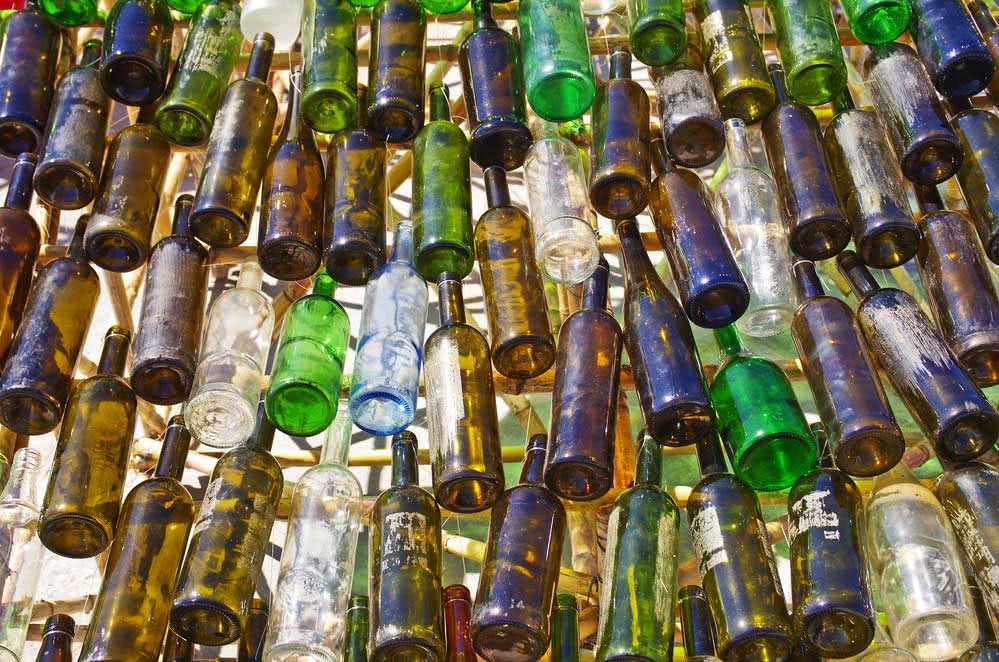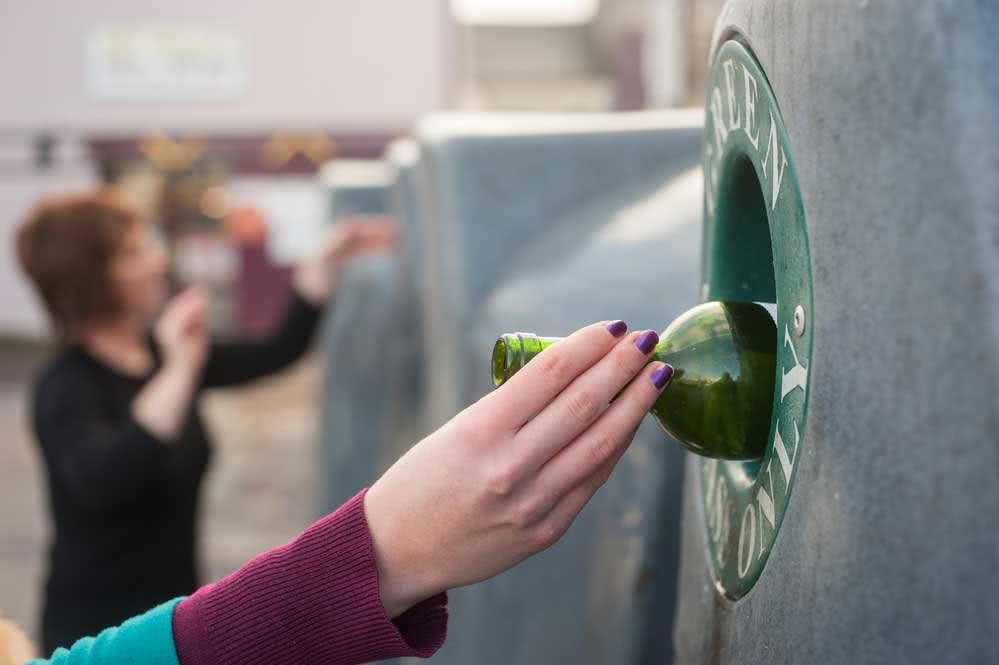You can bet that right now, at this very moment, you have at least one glass bottle in the fridge and a small pot (also glass) somewhere in the closet.
This is one of the materials preferred by the industry for the manufacture of packaging. So far so good.
The question that remains is: what do you do with that glass after its contents have already been used?
Unfortunately, even today in Brazil, most of these packages end up in the common garbage.
But if you want to give a more conscious and environmentally friendly destination, then already know that recycling glass is a very interesting solution to solve this problem.
Shall we better understand how it is possible to recycle glass in Brazil? Follow the post with us.
Understanding glass and its origin

Glass is one of the only materials that can be considered as infinitely recyclable, that is, it can be recycled countless times without losing the original characteristics of quality, resistance and durability.
But, after all, what makes glass such a noble material? Glass is the result of a combination of different substances, including sand, limestone, sodium carbonate and aluminum oxide.
This mixture is brought to high temperatures, molded and then cooled until it becomes the containers and packaging we know.
Glass is estimated to have appeared among the Egyptians more than four thousand years ago. And the most interesting thing is that these first artifacts made of glass remain unchanged today.
In other words, this only proves the theory that glass takes at least ten thousand years to decompose in nature. However, some scientists believe that the material can remain unchanged for up to a million years. A lot of time, isn’t it?
Glass recycling in Brazil: context, impact and difficulties

Every year Brazil produces about 980 thousand tons of glass packaging. Not to mention the other products manufactured with the material, such as windows, windshields, lamps, among others.
And what’s the problem with that? Only 45% of all this glass produced is destined for recycling. The rest accumulates in landfills or ends up in inappropriate places, such as river and forest slopes.
In addition to polluting the environment, all this non-recycled glass turns into a waste of natural resources and raw materials.
This is because glass is a 100% recycled material, that is, each ton of discarded glass generates the same ton of recycled glass. There is no waste in the process, nor leftovers. The use is total.
With this, the need for extraction of raw material decreases and the consumption of water and energy used for manufacturing also. Not to mention the reduction in the production of CO2 and other gases responsible for the greenhouse effect.
It is estimated that recycling just one glass container saves enough electricity to light a 100W lamp for 20 minutes.
Another great advantage of recycling glass is the generation of jobs and income. Waste pickers, cooperatives and companies that buy this type of waste have the potential to move millionaire figures into the Brazilian economy.
Data from the recycling sector indicate that companies that work with the sale of recycled glass waste can handle up to R $ 270 thousand per month.
But why doesn’t it happen? If glass recycling is so beneficial to the environment, society and the economy, why is it no longer stimulated?
The biggest obstacle in relation to recycling in Brazil is still in the precarious selective collection service. Currently, very few cities do this work. As a result, the population also ceases to be informed and aware of the importance of recycling.
Another difficulty is the low value of this product for collectors and cooperatives, which automatically discourages commercialization.
Glass logistics is also a factor that impacts recycling. First because there are few companies that process the packaging, the second reason is the difficulty in transporting the material, since these few companies are often distant from the collection sites, making access more difficult and making the process more costly.
Law No. 12.3025 / 2010, which establishes the National Solid Waste Policy, provides for a series of actions aimed at stimulating and encouraging recycling.
Some companies attentive to the issue of sustainability propose, together with their customers, reverse logistics actions. That is, the packaging after being used by the consumer and returned to the company through collection points and the company must offer the most appropriate destination or reuse it within its processes.
The most common example is returnable beverage bottles. In addition to paying cheaper, the consumer still collaborates with the correct destination of the packaging.
Glass recycling process: how and where to do it

When you see all this, you must be thinking how to do your part and contribute to the sustainability of the planet.
With regard to glass recycling, the process is simple. First, it is important to know and identify the different types of glass in order to make the correct destination. Here are the categories of glass that can (and should) be sent for recycling:
- Glass containers (hearts of palm, corn, preserved foods, jellies, sweets, among others)
- Glass bottles (wine, soda, beer, etc.)
- Medicine packaging made of glass
- Perfume bottles, lotions, creams and cosmetics
- Plates, bowls, glasses and crockery in general (Attention: do not confuse glass with ceramic and porcelain, these materials are not recyclable)
- Window and door glass
- Car windshield
- Broken glass from any packaging mentioned above
All of this waste can be sent for recycling, but always carefully packed in plastic bags or cardboard boxes so that they do not break during transport.
For the recycling of broken glass it is important to wrap and identify the pieces in cardboard or newspaper in order to avoid accidents with the professionals involved in the selective collection.
Lamp recycling should be done at specific collection points for the material, usually found in supermarkets and construction material stores.
After separating all the recyclable glass, you must send it to a cooperative or deliver it to scavengers, this, of course, if your city does not have selective waste collection yet.
Some internet sites, such as eCycle, for example, offer a complete list of cooperatives where it is possible to deliver recyclable materials. You just have to inform your zip code that the system searches the collection point closest to your home.
Recycling glass bottles

The recycling of glass bottles follows the same logic mentioned above. However, it is worth noting whether the brand offers a reverse logistics system.
Usually soft drink and beer packaging do this job. In this case, just go to the nearest point and exchange the empty package for a full one paying the difference.
Upcycling: a new look at “garbage”
As always, it never hurts to repeat that before even thinking about recycling it is important to practice the 5 R’s of sustainability: rethinking, refusing, reducing, reusing and lastly, recycling.
Recycling is the last stage in the production chain and the so-called circular economy, where the focus is on consumer awareness.
That is why it is always important to remember that recycling is not the path to sustainability. On the contrary, this path first passes through the reduction and reframing of consumption habits.
Then, the reuse of what has reached the end of its useful life must come into play. Currently, this concept is now called upcycling, that is, reuse.
Does the glass jar really need to be thrown away? Can’t you turn it into something in your house? Suddenly a vase, a trinket rack or a food rack?
Certainly it will be possible to use these packages for other functions. Glass bottles, for example, can be easily converted into decorative pieces and long neck ones can even be turned into glasses.
The internet is full of ideas in this regard. Want to see? So just take a look at these three glass recycling ideas for you to do at home:
What to do with glass bottles
Ideas with glass jars
How to make glasses out of glass bottles
Did you see how easy it is to give your glass containers a new destination? And when you can’t reuse, you know, just send it for recycling.



